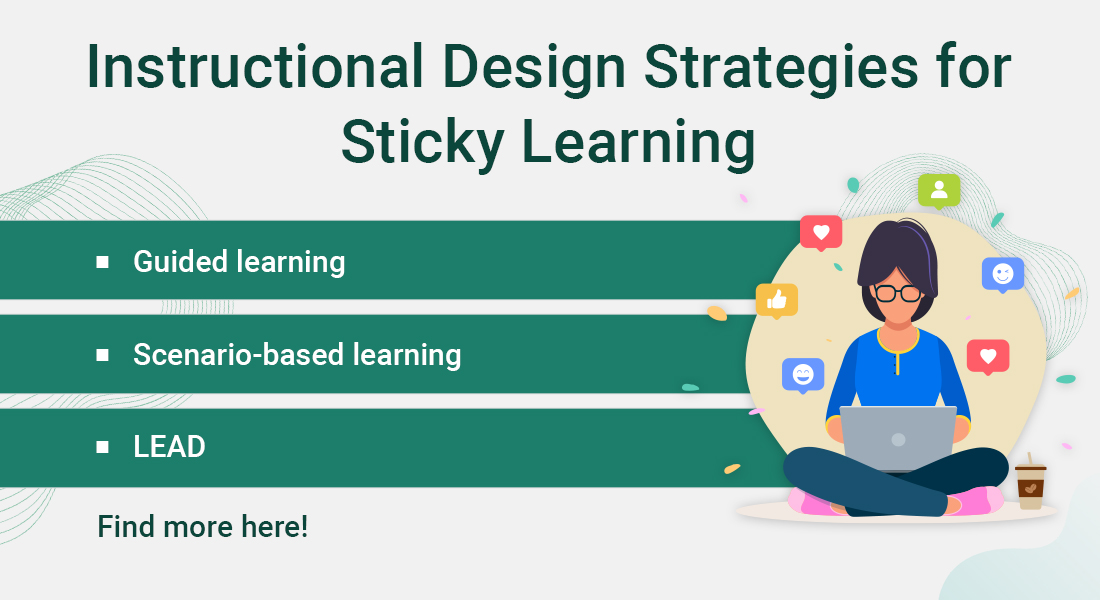5 Principles of Good Instructional Design You Shouldn’t Miss

In today’s technology-enriched culture, learners assume knowledge is freely available and need it to be accessible quickly and easily. Indeed, if they don’t find the solution they need in one place, they quickly move to another source. An ideal solution to win these learners who live in a technology-saturated environment is introducing them to eLearning. However, before we delight in the enormous opportunities of this digital learning approach, we need to understand that a great deal of thought goes into the development of an custom eLearning course. To make eLearning courses appealing to our learners, we need to follow good instructional design principles, such as the ones shared in this blog.
Principles of Good Instructional Design
- Identify learner requirements
- Bring every learner on the same page through a pre-test
- Follow a modular structure
- Conduct practice exercises after each module
- Provide immediate feedback after each assessment question
Let’s see what these principles are how each of them will help to strategically design a custom eLearning course that would meet learner challenges.
Principles of Good Instructional Design
1. Identify Learner Requirements
All learners are not the same. Some learn by reading, others by watching or doing. To design an effective eLearning course that would appeal to all learners, we need to identify what their learning requirements are.
For example, if we want to design a course for employees with years of experience in their domain and hard pressed for time, the pace of our course will be faster, and the course will be provided in short modules. In addition, these microlearning solutions if provided in mobile-friendly formats would help learners with pre-existing knowledge to quickly skim through the subject matter at their own convenient space and time.
Similarly, if the learners are kinesthetic, we can focus on courses that have physical components in the form of interactivities and multimedia. Thus, before designing an online course instructionally, we need to decide on the following factors:

- In what format should the course be provided to learners? Based on learner preferences, decide whether to provide the course in pure eLearning format, whether to incorporate microlearning formats such as videos or quizzes, or whether to go for a blend of eLearning and classroom training.
- How are learners expected to practice the acquired knowledge and what’s the extent of practice required? We can offer learners watch-try-do simulations where they can practice what they have learned in a risk-free environment. An eLearning course can also be followed by an instructor-led workshop where learners can reinforce knowledge by practicing the acquired knowledge.
Watch the Watch-Try-Do method for effective software training. Learn, practice, and apply skills to avoid costly mistakes!
- Course completion criteria and the means for measuring proficiency.
- Communication media to be used. Is the course going to be desktop based? Do learners expect it to be available on their mobile devices such as smartphones, tablets, and laptops?
A global leader in manufacturing wanted to offer product training to its new millennial sales force. They realized a multi-device compatible product-video would be an ideal choice to train the tech-savvy sales team. Short videos of three to five minutes duration were developed in the MP4 format, which enabled learners to access them on their mobile devices. The sales team also leveraged these videos by repurposing them as refreshment training material before meeting clients. This helped the sales team successfully showcase their expertise and generate more leads.
2. Bring Every Learner on the Same Page through a Pre-Test
How do we identify what our learners already know? Pre-tests will help us score learner knowledge before we commence an online course. Based on the score of this quiz, respond to learners’ level of understanding and customize the course accordingly to their needs. The score also helps us decide whether to direct learners to an advanced level eLearning course or an expert assisted hands-on training.
A pre-test helps motivate learners by creating a ‘want’ in them to learn. It allows learners understand what they know and don’t know. This understanding will further encourage learners to take up the eLearning course. It prepares them by giving a glimpse on what’s going to come and what they need to pay attention to while taking the course.
To continue with the example from the previous point, before rolling out the video-based product training course, an introduction video about the manufacturer and brain teasers such as pre-test in the form of multiple choice questions and drag-and-drop interactivities was provided to learners. This allowed learners to think and test their knowledge on what they knew about the product and the areas they need to improve.
3. Follow a Modular Structure
Using a modular structure for eLearning courses with each module acting as a self-contained chunk of knowledge makes learners aware of the course structure and provides more time to focus on the content rather than wondering what is expected of them. An ideal eLearning module consists of the following elements in sequence:
- Introduction
- An outline of the concepts to be discussed
- Detailed discussion of the concepts
- Formative assessments with instant feedback
- Reference material for additional knowledge in the form of links to videos and articles
- Summative assessment
Struggling to align eLearning assessments with your learning objectives? Here’s how to get it right!
Follow a consistent module structure throughout the curriculum. In this way, the first module of our custom eLearning course will serve as a template for the module structure, elements, and how they are sequenced.
For example, in an eLearning course on product training, we can breakdown the course into modules based on the complexity of the subject matter. Start the course with an introduction to the basic concepts and key terms regarding the product. As the course progresses, in the subsequent modules complex concepts and ideas can be discussed in detail followed by a video-based demonstration on its functionality.
4. Conduct Practice Exercises After Each Module

In a strategic design approach, practice exercises and formative assessments after each module is an opportunity for learners to reinforce the gained knowledge, thus empowering their skill and competency. For example, simulation-based exercises enable learners to practice the gained knowledge in real-context like scenarios. eLearning courses can amplify learner experience by stimulating them to actively experiment, reflect, and answer the questions posed at the end of each module.
5. Provide Immediate Feedback After Each eLearning Assessment Question
According to Wikipedia, assessments implement a systematic way of gathering, analyzing, and interpreting evidence to determine how well learning matches expectations, and uses the collected information to give feedback on the improvement of learners' learning.
We design and develop an instructionally rich custom eLearning course. However, what if the knowledge we attempt to communicate doesn’t get conveyed the way we planned? The purpose of providing eLearning assessments gains significance particularly in this context. Immediate feedback in a training program serves three major purposes:
- Corrects the learner
- Reinforces the learner’s knowledge
- Addresses learner’s misconceptions
A few tips to give effective eLearning feedback are:
- Provide it instantly. This will help learners clearly identify their mistake and act upon the constructive criticism instantly.
- Show learners the real-world implications of their wrong choices using scenarios and case studies.
- Explain to learners how they can fix an error in their action, skill, or behavior, rather than restricting the feedback to what the error is.
- Align feedback to the goals and objectives of our eLearning course and emphasize how rectifying an error helps in achieving the overall objective of the online course. For example, in customer service training, we can explain to the learner how a change in their behavior can lead to better customer service.
Thus, a systematic approach helps in producing high quality custom eLearning design. Hope the principles discussed will guide you in designing an effective eLearning course. For more insights on instructional designing have a look at our comprehensive eBook.





![Top 3 Instructional Design Strategies That Pair Perfectly with Rapid eLearning [SlideShare]](https://blog.commlabindia.com/hubfs/Imported_Blog_Media/instructional-design-strategies-rapid-elearning-slideshare.png)
![Migrating from ILT to eLearning? 6 Instructional Design Strategies to WOW Your Learners! [SlideShare]](https://blog.commlabindia.com/hubfs/Imported_Blog_Media/classroom-training-elearning-conversion-strategies-slideshare.jpg)